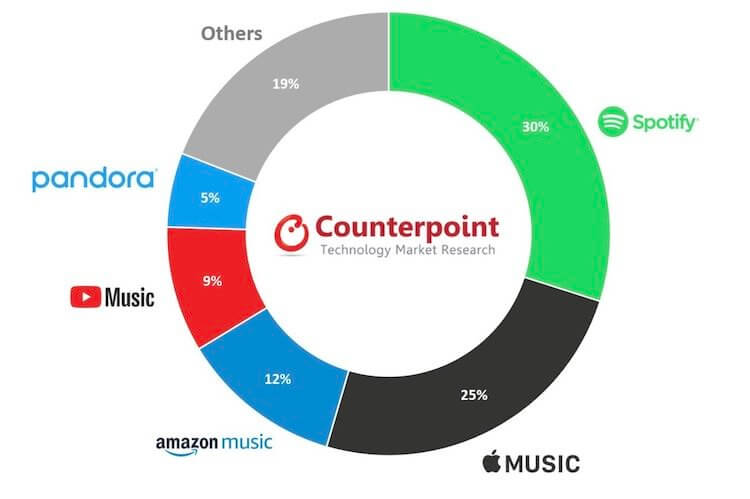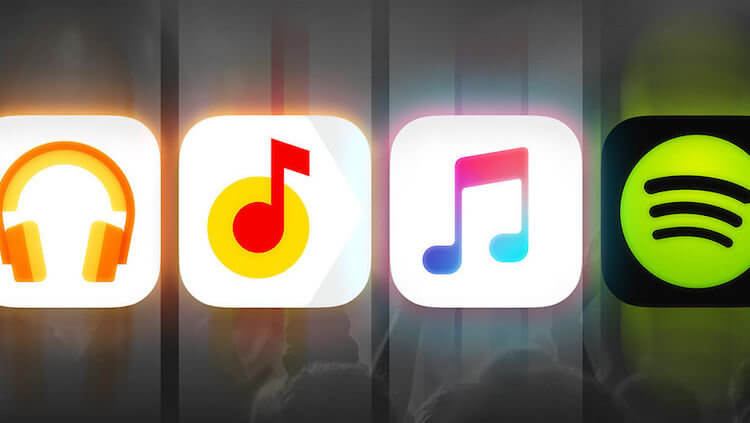Music services have been experiencing a real boom lately, which can be compared to the rise in popularity of YouTube in its time. True, by the middle of last year, the rapid growth of subscribers to Spotify, Apple Music and other services had stopped, but a few months ago it began again. As a result, we have a 35% growth in the number of subscribers. Such changes look more than impressive, but what can provide such growth in general? Was it a coincidence, a pattern, or even seasonal changes? Just a little bit, but there was another factor that set music streaming services on fire.

Streaming music becomes more and more popular every year, only sometimes there is literally explosive growth.
The rise in popularity of streaming music
Counterpoint Research analysts have conducted a study of the music services market and shared interesting results that provide answers to many questions. The first factor that influenced the growth in the popularity of music services can be considered the coronavirus pandemic and the fact that people were sitting on self-isolation for a very long time by modern standards and they had to do something. The freed up time, even if they continued to work remotely, people occupied themselves with online entertainment. And so all over the world.
Spotify benefited the most from this situation, with its subscriber base growing 30% to 394 million users. Growth percentages are on an annualized basis.
Music streaming platforms are focused on expanding reach. They do this through agreements with equipment and content manufacturers, and they need growth in order to make money on the turnover. The more users give the company a commission, the more it will earn. It's simple.
Couldn't help but influence the growth and promotion offers. For example, promotional codes, trial subscriptions, and family subscriptions. Also, a great contribution to the development of popularity was made by entering new music markets, where it was possible to negotiate with copyright holders so that the subscription price was lower. For example, in Russia, all major music streaming services cost 169 rubles per month for an unlimited subscription.

Nowadays, music is very inexpensive, and access to it has never been easier.
Paid online music subscriptions
There is also not only an increase in the total number of subscribers, but also an increase in paid subscribers. Research analyst Abhilash Kumar noted that people are more willing to switch from the free version of use to the paid one. Let me remind you that the free version usually works with ads, with lower quality or does not allow downloading music for offline listening. Sometimes these disadvantages are combined in different ways.
The growth in the number of paid subscribers was 20%. This suggests that it is difficult to attract new users, but when they are already hooked on this way of getting music, they understand all its convenience and are ready to switch to the paid version.
The largest music services
At the moment, Spotify remains the most popular music service in the world. Its market share in monetary terms is 30%. If you look at the number of subscriptions, then it occupies 30% of the industry. It is followed by Apple Music (25% of money, 21% of subscriptions) and Amazon Music, which grew by 104% in the quarter and was able to take third place.

This is how users' preferences were distributed.
The popularity of Spotify in Russia
Spotify's growth has been primarily seen in the Asia Pacific and Latin America regions. It is still impossible to talk about the influence of the Russian market on the world picture, since the report was prepared before the service appeared in Russia. In addition, too little time has passed in order to gain a large customer base. Although, Spotify may not be so popular in Russia, because Yandex offers its Yandex Plus subscription with us. Taking into account the discounts she gives on taxi and car sharing, it is enough to use them a couple of times a month and the cost of the subscription will pay off.
But in the Indian market, Spotify has indeed managed to achieve significant growth. Moreover, he came to him long enough to influence the annual statistics. By the way, the price there still seems to be very high by Russian standards – 699 rupees (about $ 9 or 650 rubles) per month.
Promotional codes for music and additional services
In addition, some services, including Spotify, have begun offering new services like Spotify Kids, aimed at parents with young children. And the service Apple Music has expanded to 52 countries and offers six months of free subscription there, instead of three, as it was before. In addition, Apple is constantly adding new features to its platform. For example, starting with iOS 13.4.5, users can share their music on Instagram and Facebook, thereby increasing their social media engagement.

Services compete among themselves for each user.
The reason Amazon Music grew 104% YoY is because its Amazon HD offered 90 days of free music in the first quarter of 2020.
Due to the fact that users around the world have become much less likely to leave their homes in recent months, analysts have noted a change in user priorities. For example, the number of listening to music through the Android Auto and Apple CarPlay systems has greatly decreased, but smart speakers have begun to be used more actively. And the place of just music was partly taken by thematic podcasts, for example, from the category “sports and health”.
As a result, the coronavirus, which has had a very negative impact on many areas of our life, has had an extremely positive effect on the growth in popularity of streaming music services. Market players continue to fight more and more fiercely for users. We have already received all the music that only large studios have at their disposal, and the emergence of new content does not depend much on music services. It turns out that they will only have to attract us with new functions and lower prices. Let's see what happens, but competition is always good for the buyer and even for the seller who wants not only to make money without doing anything, but really strives to develop his product.
